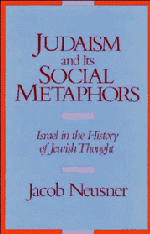Book contents
- Frontmatter
- Contents
- Preface
- List of Abbreviations
- Introduction
- 1 Imagining Society, Re-visioning “Israel”
- PART I “Israel” in the First Statement of Judaism, 70–300 C.E.
- PART II “Israel” in the Second Statement of Judaism, 300–600 C.E.
- 6 “Israel” on Its Own Terms
- 7 “Israel” as Family
- 8 “Israel” as Family and Also Singular Nation
- 9 “Israel” as Sui Generis
- 10 The Second Phase of the Judaism of the Dual Torah and Its Social Metaphors
- PART III Same Metaphors, Other Systems
- General Index
- Index to Biblical and Talmudic References
6 - “Israel” on Its Own Terms
Published online by Cambridge University Press: 04 August 2010
- Frontmatter
- Contents
- Preface
- List of Abbreviations
- Introduction
- 1 Imagining Society, Re-visioning “Israel”
- PART I “Israel” in the First Statement of Judaism, 70–300 C.E.
- PART II “Israel” in the Second Statement of Judaism, 300–600 C.E.
- 6 “Israel” on Its Own Terms
- 7 “Israel” as Family
- 8 “Israel” as Family and Also Singular Nation
- 9 “Israel” as Sui Generis
- 10 The Second Phase of the Judaism of the Dual Torah and Its Social Metaphors
- PART III Same Metaphors, Other Systems
- General Index
- Index to Biblical and Talmudic References
Summary
From the Mishnah to the Yerushalmi
The second statement of the Judaism of the dual Torah emerged in writings that came to closure between the time of Constantine, after ca. 300 c.e., and the rise of Islam in the Middle East, ca. 640 c.e. The first important document of that period was the Talmud of the Land of Israel or Yerushalmi, closed at ca. 400 c.e., and the last, the Talmud of Babylonia or Bavli, closed at ca. 600 c.e.
Looking backward from the end of the fourth century to the end of the first, a generation beyond the destruction of the Jerusalem temple, the framers of the Yerushalmi surely perceived what need not have appeared obvious and unavoidable, namely, the definitive end, for here and now at any rate, of the old order of cultic sanctification. After a hundred years beyond the destruction of Jerusalem in 70 c.e., there may have been some doubt. After two centuries more, however, with the total fiasco of Julian's project of rebuilding the temple in 362–3 c.e. near at hand, there can have been little hope left for a near-term restoration. The two foreordained dates therefore had passed – three generations beyond the destruction yielding the disappointed hope invested in Bar Kokhba, three hundred years (more or less) the disgraceful failure of Julian's temple. The Roman emperor who, in his war with Christianity, would have made himself (from Israel's perspective) into the new Cyrus died in war with Iran, and the hope for a restored Jerusalem in the near term perished as well.
- Type
- Chapter
- Information
- Judaism and its Social MetaphorsIsrael in the History of Jewish Thought, pp. 95 - 111Publisher: Cambridge University PressPrint publication year: 1989



